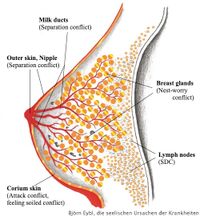Breast Glands
The breast glands are derived from the corium skin, which has bulged inward and given a different function.
Also see outer skin, corium skin (the part of the breast) and milk ducts.
Whether it involves the left or right side of the body depends on biological laterality.
Themes
- Worrying about a loved one.
- Having a conflict with the loved one, that is, "fighting" or arguing with a loved one.
- Problems concerning the "nest." Conflicts within the family or group one lives with or regarding a house or home.
The conflicts are not sexual in nature.
CA phase
Increase of cells in mammary gland, breast cancer.
Biological purpose
Increased production of breast milk to better care for someone.
Symptoms
Possible palpable thickening in breasts. No pain.
With prolonged or intense CA phase: swelling may become large.
PCL phase
Functional normalization. Decomposition of cells by TB bacteria, if present, otherwise encapsulation of tumor.
Symptoms
Breast infection, breast cancer. Extreme fatigue, night sweats, pain, possible elevation. More severe / large swelling with the syndrome.
Because there are often other conflicts involved, like SDC's ("I didn't take good care of my child or partner" or "there is something wrong with my breast"), there are often programs in the lymph nodes or bones near the breasts. These are seen as "metastases" and treated as such.
EC
Strong pains, chills and cold sweats. Discharge of healing fluid through lymph and blood (normal), possible outward eruption of infection with foul-smelling pus. This happens more frequently after a puncture is performed: the way out is prepared.
Surgical removal of the breast is recommended if the person feels disfigured or soiled because of the program. The program itself is the trigger and it becomes a hanging healing that the person often cannot get out of.
At the end of the program, calcium deposits may be found. These are considered precursors of a malignant, invasive breast cancer and amputation is usually advised.

